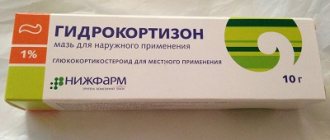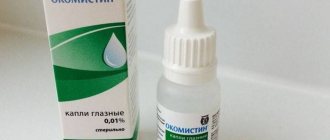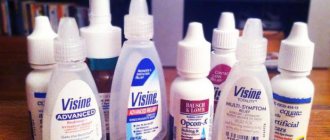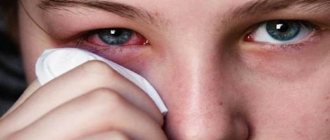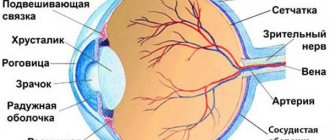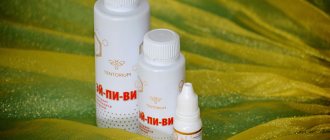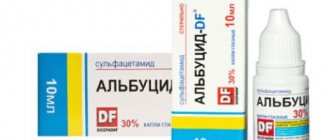Updated: 08/28/2020 12:39:45
Expert: Boris Kaganovich
*Review of the best according to the editors of expertology.ru. About the selection criteria. This material is subjective in nature, does not constitute advertising and does not serve as a purchase guide. Before purchasing, consultation with a specialist is required.
Many of us are accustomed to the fact that medications must mainly be taken orally (of course, unless we are talking about seriously ill patients who are in the hospital). There are tablets, mixtures and powders for this. But in case of an allergic reaction, topical liquid dosage forms can help most quickly: these are eye drops and nasal drops, or metered-dose nasal sprays.
Why is this so? The fact is that a local allergic reaction is inextricably linked with the place of introduction of the allergen into the body, and those tissues that separate the body and the external environment can be either skin or mucous membranes lined with epithelial cells. The skin is fairly well protected from the effects of numerous allergens, but even with it, misfortune can happen: a wasp sting, or contact dermatitis caused by an allergen or chemical.
But the mucous membranes are a more delicate structure, they are very well supplied with blood, and in the case of the introduction of an allergen, they react with edema, the production of biologically active substances, interleukins, and histamine by tissue basophils and T-lymphocytes. And as a result, lacrimation, rhinorrhea, intense itching occurs, and in some cases, Quincke's edema. The symptoms are further aggravated by the fact that it is on the mucous membranes of the nasal cavity and conjunctiva of the eye that class E immunoglobulins, or reagins, which are also called mediators of allergic reactions, may be found in excess.
This all leads to the fact that the most rapid effect, rapid relief of painful allergy symptoms, is possessed by the so-called organotropic drugs: ophthalmic drugs in the form of eye drops, and drugs in the form of nasal drops. The most effective and popular allergy drops for adults and children are listed below.
Symptoms of hypersensitivity
Eye irritation is provoked by contact of the conjunctiva with various allergens. They often play a role in dust, plant pollen, animal hair, as well as various chemicals and gases. Eye irritation can also be caused by other medications or accompany infectious diseases. In any case, the reaction can develop rapidly and cause maximum discomfort after just a few hours, or it can bother the patient in a mild form for a long time.
Even if irritation occurs in only one organ of vision, anti-allergy eye drops should be used on both, since they are interconnected, and the allergy can easily spread to the weakened organ subsequently. Most often, the allergy begins in both eyes at once, causing itching, burning, redness, pain in the eyes, lacrimation, swelling and increased sensitivity of vision. In advanced forms, when an infection is already added to the allergy, all of the listed symptoms are accompanied by purulent discharge.
Symptoms and manifestations of the disease
It has been established that exposure to household allergens, including cleaning products and detergents, is mainly manifested by dysfunction of the upper respiratory tract and local skin lesions (dermatitis, rashes), and irritants from the external environment cause a whole chain of reactions, which may include the following symptoms:
- sneezing;
- itching;
- redness of the skin, expressed by small pinpoint or extensive rashes, sometimes very itchy;
- nasal congestion;
- redness of the mucous membrane of the eyes, clear translucency of the vascular pattern;
- tearfulness;
- photophobia;
- burning on the eyelids and whites of the eyes;
- puffiness and swelling of various parts of the body;
- itching, slight swelling and dryness in the throat;
- cough and sore throat and larynx;
- chills and fever;
- attacks of suffocation;
- inflammation of the mucous membrane of the respiratory tract;
- headache and dizziness;
- lethargy, apathy;
- fatigue;
- and drowsiness;
- impaired concentration;
- irritability.
Each of these symptoms causes discomfort and inconvenience, but some are dangerous because they can lead to the development of pathology of vital organs.
Action of the medicine
Anti-allergenic eye drops work directly at the source of irritation, therefore they relieve unpleasant symptoms faster than any tablets. In addition to treating existing irritation, such products can be used as preventatives during the flowering season or before planned contact with an allergen (for example, visiting a place where there are pets).
Allergies occur due to the malfunction of the immune system, which perceives harmless things as a danger to the body and produces special substances - histamines - to protect against them. It is to block or suppress their production that many allergy medications are aimed. The best eye drops not only eliminate unpleasant symptoms, but also fight the causes of irritation. Along with such remedies, you can also purchase inexpensive drugs that only work to relieve irritation. These include decongestant, vasoconstrictor and corticosteroid drops. It is important to remember that their action is ensured by certain components in the composition, which, with prolonged use, can provoke a deterioration in the condition and the emergence of new serious diseases of the visual organs, such as glaucoma, corneal pathologies, and so on.
The role of histamine in allergies
Histamine is a substance that is released by the human body in response to irritation caused by a particular allergen. Histamine is produced by mast cells, which are part of the immune system. The release of histamine and subsequent lacrimation, itching or redness are alarm signals that indicate that the normal functioning of the body is disrupted. Until it is restored, the manifestations of the allergic reaction will continue.
It is not always possible to avoid a situation in which a person reacts to an allergen. And the symptoms of such a reaction urgently need to be relieved, since it causes discomfort at work in the office, when driving a vehicle or in situations relating to personal life. Antihistamine eye drops for allergies are designed to prevent the release of histamines and the manifestation of symptoms that can complicate a person’s life. However, you need to think in advance about how the body will react to the medicine.
Main manifestations and symptoms of allergies
The use of allergy eye drops may be contraindicated during pregnancy or in children under 6 years of age.
The chemical composition of allergy eye drops may contain components that have side effects. In addition, unlimited use of the same drug causes the body to become accustomed to it, making treatment ineffective. If the source of the allergic reaction can be influenced - for example, by stopping using cosmetics - then it is best to eliminate the cause itself, rather than deal with its consequences.
Antihistamines
Such medications can rightfully be called the most effective eye drops for allergies. They can be used for a long time to prevent and treat irritation of the organs of vision. The remedies not only eliminate unpleasant symptoms, but also fight the cause of their occurrence, blocking the synthesis of histamines. Very often, such drops are used during seasonal allergies.
Timely initiation of treatment always prevents the occurrence of itching, burning and redness of the eyes due to the creation of a special protective barrier and the elimination of immune pathologies. Since seasonal irritants can cause negative reactions throughout the body, eye drops for ragweed allergies can be prescribed in combination with other antihistamines that prevent choking, coughing, allergic rhinitis and other symptoms.
How to correctly determine which drops are needed?
In order to eliminate unpleasant signs of allergies (swelling, hyperemia, conjunctivitis), local treatment will help - medications with antihistamine, vasoconstrictor, anti-inflammatory effects.
Each type of eye drops has its own pharmacological action and contraindications for use.
This is why you cannot use medications without a doctor’s prescription, so first of all you need to contact an ophthalmologist or ophthalmologist for advice.
Eye drops in combination with other methods of influence can be far from safe.
Taking into account the existing symptoms, it is possible to carry out monotherapy exclusively with eye drops or combine them with other methods of treatment in combination to achieve maximum effect.
Corticosteroids
These products include drops with an anti-inflammatory effect, because it is inflammation that provokes most of the unpleasant symptoms of allergies. These hormonal drugs will help you quickly cope with acute reactions of the body, but before using them you should consult a specialist, since the drugs have many limitations.
Non-steroidal drops will also help to quickly relieve inflammation. Unlike the previous ones, they can be used regularly, but the effectiveness is an order of magnitude lower.
Vasoconstrictors
When looking for emergency help, you should pay attention to these drops. Allergies (itchy eyes, uncontrollable lacrimation and pain) can strike at the most inopportune moment and there is not always time to wait for the really necessary remedy to work.
Vasoconstrictor drops provide relief within a quarter of an hour after instillation and remain effective for several hours. The only limitation is the frequency of their use. Such drugs can be addictive and should therefore be used only in extreme cases.
General rules of application
Regardless of which eye drops for allergies are chosen, expert reviews recommend using them according to general recommendations:
- First you need to thoroughly wash your hands, prepare wipes to remove excess medicine and the drops themselves.
- It is not recommended to wear contact lenses during therapy; it is better to replace them with glasses so as not to provoke even more irritation of the mucous membranes. If there is an urgent need, before using the medication and lenses, you should remove them and put them back only 15 minutes after the procedure.
- For convenience, it is better to lie on your back, but you can simply tilt your head back.
- You need to pull down the lower eyelid with your free hand and drop a few drops into the eye, then close it and wait a little. Any excess that flows out should be removed with a napkin.
- During the procedure, it is very important not to touch the eye with the pipette or bottle, so as not to introduce harmful microorganisms into it.
In addition, you must follow all the doctor’s recommendations, study the instructions and do not use the product for longer than the permitted period. Some allergy medications, including drops, can cause drowsiness and are prohibited while driving machinery or vehicles, which is something you must pay attention to before starting treatment.
Rating of the best allergy drops
| Nomination | place | Name of product | price |
| Eye drops | 1 | Azelastine (Allergodil) | 508 ₽ |
| 2 | Olopatadine (Opatanol, Olopatallerg, Oloridine) | 616 ₽ | |
| 3 | Cromoglicic acid (Lecrolin) | 66 ₽ | |
| 4 | Levocabastine (Vizin Alergy) | 420 ₽ | |
| 5 | Dexamethasone (Maxidex, Oftan Dexamethasone) | 177 ₽ | |
| 6 | Diphenhydramine+Naphazoline+Zinc Sulfate (Ocumethyl) | 414 ₽ | |
| 7 | Interferon Alpha-2b+Diphenhydramine (Ophthalmoferon) | 400 ₽ | |
| Allergy nasal drops | 1 | Fluticasone (Flixonase) | 345 ₽ |
| 2 | Ipratropium bromide + xylometazoline (Xymelin Extra) | 230 ₽ | |
| Antiallergic drops inside | 1 | Cetirizine (Zodac, Zyrtec) | 112 ₽ |
| 2 | Dimetinden (Fenistil) | 95 ₽ |
Drops for adults
Almost any eye drops for allergies can be prescribed for adults, but for children there are certain restrictions that should be discussed separately. The working population with allergic reactions to the eyes most often uses Dexamethasone drops to eliminate unpleasant symptoms.
This drug belongs to the group of anti-inflammatory drugs, but differs from similar drugs in a minimal list of contraindications. Children under 6 years of age are prohibited from using the product. The course of treatment is prescribed and determined only by a specialist, based on the individual characteristics of the course of the disease. It is impossible to correctly determine the period of therapy on your own, even with instructions.
In the first days, acute symptoms are relieved by using the medicine every hour, and after relief, treatment is continued with three instillations per day.
Maxitrol anti-inflammatory eye allergy drops for adults have also proven themselves well. This drug is used for non-purulent forms of conjunctivitis. Characterized by fast action and high efficiency. This is ensured by potent substances in the composition, which automatically prevent a long period of using drops. The course of treatment cannot be more than 7 days, and a single dosage is 2 drops in each organ of vision. In case of emergency or severe cases, instillations are allowed to be performed hourly. Conventional therapy involves instillation every 5 hours.
Eye drops for allergies called “Lotoprednol”, in addition to having an anti-inflammatory effect, also have an immune-strengthening effect. You can buy them at any pharmacy and instill them 3 times a day. The duration of treatment depends on the doctor's recommendations.
Sofradex drops have anti-inflammatory and antibacterial effects. They are designed for a long course of use, but they help relieve all discomfort from allergies quite quickly. As a prophylactic for other infections, the drug is often used in combination with other drugs. The frequency of instillations is 5 times a day.
Okumetil is also an effective drug with combined action. Drops quickly relieve swelling, inflammation, and histamine production. Contraindications include children and the elderly. Side effects include blurred vision, drowsiness and increased eye pressure, so should be used with extreme caution.
Treatment of allergies in children
The body of children under 3 years of age is at the stage of formation, so the intake of certain medications can lead to unpredictable consequences, complications, worsening symptoms, and a reverse effect in case of allergies.
Children over 2 years of age are allowed to use only safe, harmless drugs. It is acceptable to take systemic medications to relieve allergies in infants under 1 year of age, but only with the permission of the attending physician.
Children should not use drops for allergies without consulting an ophthalmologist. A number of medications can cause severe harm instead of the intended benefit and worsen the existing symptoms of conjunctivitis.
More effective and safe eye allergy drops include:
- Allergodil, an antihistamine drug suitable for use in children over 4 years of age. Quickly relieves swelling, itching, redness. Average price 400 rub.
- Zodak has a mild antihistamine effect and can be used by infants at 6 months, side effects are minimal. Price 150-200 rub.
- Zyrtec using dosages only as prescribed by a doctor. In case of overdose, side effects are possible: drowsiness, apathy, loss of appetite. Cost 300 rub.
- Cromohexal for children over 4 years old to relieve allergies, inflammation, irritation, and stop the anti-inflammatory course. Average price from 100 rub.
Allergodil
Cromohexal
Zyrtec
Zodak
It is possible to prescribe vasoconstrictors for allergies (Vibrocil, Prevalin) to babies under 1 year old, but not more than 4 days in a row.
Drugs with hormonal effects are not prescribed to children under 12 years of age and can be used only in extreme cases in severe cases of the disease. Dosages and types of drugs are selected by an ophthalmologist.
Parents should consider the following recommendations when administering eye drops to their children:
- place the child on his back;
- throw back your head;
- pull down the lower eyelid;
- add 1-2 drops;
- ask the baby to close his eyes for 2-3 minutes.
The composition must be applied to a clean face without any makeup or lenses. For 1-1.5 hours after instillation, it is not advisable to wear glasses, watch TV, read a book, or go outside.
Products for babies
Eye drops for allergies for children have a lower concentration of active ingredients, which reduces the load on a fragile, growing organism. You can use drugs from different manufacturers at different ages, the limitation of which guarantees safety.
The first name for eye drops for allergies, allowed for children from 3 years of age, is “Opatanol”. This drug is a histamine receptor inhibitor and is used for allergic conjunctivitis. The main active ingredient of the drops is opatadine hydrochloride, which acts as the main blocker. The composition also contains a preservative, which means that the drops can only be used if you do not have contact lenses. It is prohibited to use the product while operating machinery. According to the instructions, the drug "Ketotifen" cannot be used for patients under 12 years of age, but in special cases experts recommend drops earlier. Their active substance ketotifen helps slow down the production of histamines and begins to act much faster than similar drugs.
Lecrolin eye drops have proven themselves to be effective for pollen allergies. This product is approved for use in children over 6 years of age for various irritations caused by allergies. The active ingredient sodium cromoglycate stabilizes cell membranes and slows down the production of histamine. The drug received excellent reviews when used as a prophylactic agent. Available in tubes and bottles with different compositions.
From the age of four, children can be prescribed additional eye drops for allergies. Their name is “Azelastine”. The product has an antihistamine effect, is used as a preventative during the flowering season and can be used for a long time without harm to health.
Types of allergies in the eye area
Before using anti-allergy eye drops, people should contact a healthcare provider for advice. Any medications for this pathology should be prescribed by specialists who will carry out a set of diagnostic measures and determine the cause of the development of the disease. Doctors must differentiate allergies in the eye area from other pathologies that have identical symptoms.
Modern medicine identifies the following types of allergies that develop in the eye area:
- Pollinous form of conjunctivitis . As a rule, people develop this pathology when they are allergic to wild or domestic plants. The reaction appears not only in the eye area, but also on other parts of the body. Bronchospasm may develop and shortness of breath may appear. When you have an allergic reaction to pollen, a person begins to sneeze.
- Dermatitis with allergic etiology . In patients, the pathological reaction manifests itself in the eyelid area. The skin swells, begins to turn red, itch very much, and characteristic rashes appear on them. In most cases, patients encounter this form of dermatitis due to the use of low-quality cosmetics. The disease can also develop in people who work in hazardous industries or in the construction industry, where they are forced to systematically come into contact with chemical and aggressive environments.
- Conjunctivitis, allergic etiology . This pathology can occur in both acute and chronic forms. Patients develop a strong inflammatory process on the mucous membranes, which provokes not only redness and itching, but also profuse lacrimation.
- Angioedema , which appears when people use certain groups of medications. This pathology can also develop due to the consumption of certain foods. Patients feel rapidly deteriorating, not only the eyelids, but also the entire eyeball swells greatly. Doctors prohibit this category of patients from independently using medications to relieve unpleasant symptoms, as this can lead to the development of Quincke's edema and anaphylactic shock.
- Keratoconjunctivitis . This disease is a more severe form of hay fever conjunctivitis. In patients, papillary-like neoplasms appear in the eyelid area. At the same time, symptoms characteristic of an allergic reaction appear. Young patients are more susceptible to this disease.
Inexpensive drugs
With regard to medicines, the rule “cheaper means worse” does not always apply, since the cost of medicines may depend on the country of origin, but the composition of the drugs will be absolutely similar. Inexpensive eye drops for allergies for adults can be found at any pharmacy. One of the most effective remedies in this price category is the drug “Cromohexal”. Its active ingredient sodium cromoglycate helps block histamines and stabilize mast cell membranes. Thanks to this, the drops eliminate irritation of the mucous membrane, relieve inflammation and can be used for prevention. Use drops 4 times a day. Exceeding the dose or frequency of instillations can lead to headaches, dry eye mucosa, suffocation and anaphylactic shock. It is prohibited to use drops while operating machinery.
An excellent alternative to the previous drug are inexpensive eye drops for allergies “Polynadim”. They act comprehensively due to the presence of naphazoline, diphenhydramine and diphehydramine. The drug relieves swelling, inflammation, pain, and blocks histamine receptors. Efficiency in several directions is simultaneously countered by a wide list of side effects and prohibitions for use, so drops should be used with caution.
Maximum effect
If you do not pay attention to the cost of the drops and look only for an effective remedy, then among the assortment offered by pharmacies you can highlight several other drugs. Their price belongs to the high segment, but they cope with allergies according to all requirements. One of these medications is Allergodil. A long-acting drug with an antihistamine effect. Due to its composition, it has a stabilizing effect on the membranes of vascular tissue cells, which prevents the penetration of irritants into them. The drug is approved for use in children over the age of four for the treatment and prevention of various types of allergies. Dosage, frequency of use and duration of treatment depend on the type of allergy and the recommendations of a specialist. If the dosage is exceeded, increased itching, swelling, redness and lacrimation may occur. Wearing lenses during therapy is prohibited.
Expensive but effective eye drops for allergies called “Visallergol” have virtually no negative effects, so they can be used for a long time for treatment and prevention. The maximum course of therapy is 4 months, and it is enough to drip the product only once a day. The mechanism of action of the drug neutralizes already released histamine and prevents the formation of new ones. If you need to find a drug that will relieve acute allergy symptoms in the first minutes after use, then, undoubtedly, Visin Allergy is such a drug.
The drops begin to act immediately after contact with the mucous membrane and reduce their effectiveness only after 8-10 hours, which makes it possible to feel comfortable when instilling the product twice a day. The main active ingredient of the drug is levocabastine hydrochloride, which is a long-acting histamine receptor blocker. Side effects rarely include increased allergy symptoms such as burning, itching and swelling. Rarely, dermatitis and headache may occur. Classic Visine is used only to relieve inflammation and swelling after exposure to dust, dirty water, smoke, etc., in the eyes.
The occurrence of allergies and body reactions
Allergens that come into contact with the eyes include dust, animal hair, and plant pollen. This leads to increased production of tear secretion as a protective reaction of the special gland.
The body begins to show an inadequate response to external stimuli in the form of:
- redness of the cornea, conjunctiva of the eyeball;
- swelling of the skin around the eyelids;
- decreased vision;
- dysfunction of the optic nerve;
- lesions of the mucous membrane or dermis;
- hyperemia of the upper eyelid;
- increased lacrimation.
The symptoms cause particular discomfort and worsen the quality of life. Regardless of the provoking factors, it is important to take timely measures to identify and eliminate the allergen.
The main thing is to prevent the development of complicated conjunctivitis, to prevent the inflammatory process in the retina and optic nerves at the initial stage.
Drugs for pregnant women
During gestation, expectant mothers have all their senses heightened, and it is possible that even completely healthy women may show signs of allergies. During this period of life, any medications should be used with extreme caution so as not to harm the baby and eliminate unpleasant symptoms; the drug “Levomycetin” often helps. These inexpensive eye drops for allergies can relieve all signs of eye disease in just 2-3 days of use.
In addition to anti-inflammatory drugs for the eyes, antihistamines can also be used during pregnancy. Before periods of flowering of certain plants, women in an interesting situation can take Allergodil, Lecrolin and Curtatifen. The following drops are considered absolutely safe at any time:
- "Vizin";
- "Systane-Ultra";
- "Ophtolic";
- "Khilozar";
- "Okomistin";
- "Dexamethasone";
- "Vitabakt" and others.
Conclusions about eye drops
It is possible to find strong and affordable antibiotics for the eyes. And the modern drugs proposed in the article cannot be compared in quality with the same Levomycetin, popular in the last century. If you look for ophthalmic drops correctly, you can even save money. To do this, you need to purchase eye antihistamines online or from social pharmacies. This will help both reduce costs and get medications to relieve allergies that will definitely work.
Share with your friends
Do something useful, it won't take much time
Contraindications and side effects
Almost all allergy medications have the same prohibitions on use. Common ones include sensitivity to individual components of the composition, glaucoma, cataracts and infectious diseases of the organs of vision. Absolutely all drops also have age restrictions, but depending on the active substance, permission for use can begin from 3-12 years. Wearing contact lenses while using any eye drops is also prohibited, as they can serve as an additional irritant and only slow down the process of symptom relief.
If discomfort occurs during therapy, even in the absence of contraindications, you should immediately discontinue the medication and consult a doctor for correction of further treatment.
Common side effects include drowsiness, irritability, headaches, vomiting, nausea, intestinal disorders and dizziness.
Antihistamine group
Such medications are prescribed to patients to quickly relieve allergic symptoms, redness, swelling, burning and itching. Antihistamine eye drops should be used not only for medicinal purposes when contact with the allergen has already occurred, but also for prevention.
"Lecrolin"
This antihistamine is used in the treatment of allergic reactions caused by various factors. Experts often prescribe it to patients to prevent hay fever. Despite the fact that the drops have no serious contraindications, other than individual intolerance to their individual components, they should be used with caution when treating children and pregnant women.
"Zaditen"
This medicine contains ketotifen. This active component helps to relieve unpleasant allergic symptoms as quickly as possible. Experts often use this medication to treat various forms of conjunctivitis. It can be used by children from 12 years of age. The dosage is determined individually for each patient.
"Cromohexal"
This antihistamine is intended to relieve allergic symptoms, moisturize and normalize natural processes in the eyes. It is also used for preventive purposes and during maintenance therapy. Patients should consider the following nuances:
- It is forbidden to use drops for pregnant women and children under four years of age.
- The medicine should not be used by patients who wear contact lenses.
- Side effects may develop: barley appears, a burning sensation occurs, and the mucous membranes dry out.
"Opatanol"
This medication helps eliminate allergic manifestations:
- hyperemia;
- swelling;
- tearfulness.
The components present in the medicine suppress the process of histamine production. It can be used in the treatment of children starting from the age of three.
"Allergodil"
These drops contain azelastine. This active component is capable of providing a powerful and long-lasting antiallergic effect. It has been proven effective in treating seasonal allergy outbreaks. The medicine can be used in the treatment of children starting from the age of six.
Reviews
Many people choose eye drops for pollen allergies not based on their cost, but rather on the recommendations of other people, since after paying even a small amount and not receiving any relief, many lose confidence in medications in general. In order not to endure annoying itching and avoid places where allergens accumulate, doctors recommend paying attention to time-tested remedies. "Levomycetin" and "Dexamethasone" are just such. In addition to high efficiency, positive opinions are also generated by their low cost, as well as their availability in any pharmacy.
According to reviews, Opatanol and Lecrolin drops help children cope very well with unpleasant symptoms.
For adults, the best options would be Visin A\lergy, Lotoprendol, Polinadim and Cromohexal.


